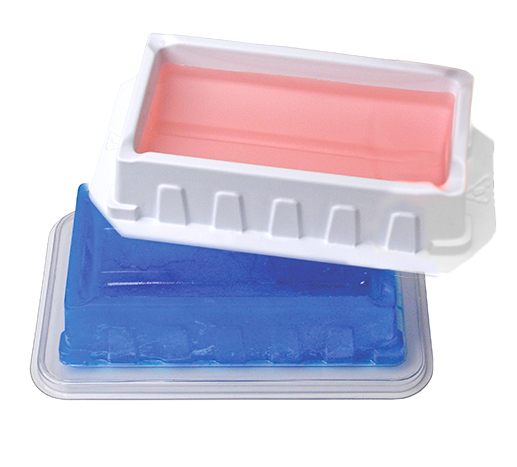
Reagent Reservoir Cooler
- Custom-fit companion for our 100 mL reservoirs
- Manufactured with non-toxic gel encased in heavy duty PVC
- Maintain your reagent at < 5 degrees for up to 1 hour

Reagent Reservoir Cooler
VistaLab Reagent Reservoirs are made of Polystyrene; with the exception of our 12 Channel Reservoir which is made of pure Polypropylene.
All VistaLab Technologies sterile disposables (Tips, Reagent Reservoirs, Wobble-not Serological pipets) are good for 3 years from the Date of Manufacture found on the Certificate of Analysis included in each case; as long as the packaging is unopened and uncompromised.
Only our 12 Channel polypropylene reservoirs may be autoclaved. We do not recommend autoclaving our polystyrene Reagent Reservoirs, as they can experience significant geometric warping.
VistaLab Reagent Reservoirs are free from ALL animal materials.
Reagent Reservoirs are manufactured in a clean room facility free from human animal contact to prevent RNase and DNase contamination. Reservoirs are then tested by an independent testing laboratory using the protocol described on the Certificate of Analysis and labeled certified RNase/DNase free if the acceptable industry standard is met.
Pyrogens are bacterial endotoxins that can be harmful to cell cultures. Reservoirs labeled non-pyrogenic are certified to have endotoxin levels below the acceptable industry standard as determined by an independent laboratory using the protocol described on the Certificate of Analysis.

 CODE: 234567 (sample)
CODE: 234567 (sample)
Order Tips Order Service Register VistaPoints
If you don’t have enough VistaPoints to get the service for free, you can still use your points and pay the difference.
I manually pipette many samples a day. That caused a lot of pressure on my shoulder and elbow, and especially my thumb when ejecting tips. I developed elbow pain and numbness that was diagnosed as carpal tunnel syndrome and required surgery. Now I'm using an Ovation and haven't had any further problems.
I used to have tennis elbow and I don't even play tennis. It was from pipetting. I had to stop for a couple of months and start physical therapy. Now I also use the Ovation. I just love it! It's so comfortable and my arm is better.
I wish the Ovation had been available 10 years ago. I'm convinced I would have never developed Carpal Tunnel Syndrome from pipetting. The Ovation uses nice, gentle motions without force. All the stresses and strains of the standard pipette are totally gone.
I was having a lot of pain in my wrist. I started using Ovation, and in less than a week, I stopped having problems!